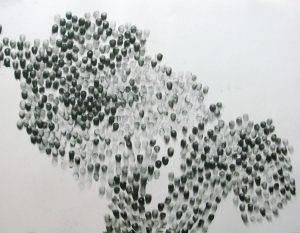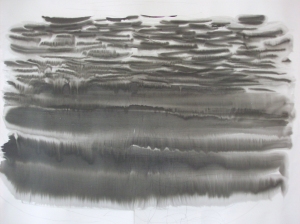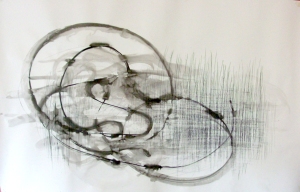It has been a while since I wrote anything here, and that is due in part to my involvement in a new class. I signed up because the class description seemed to dovetail nicely with my continued investigation into the nature of creativity and the creative process. It also offered me a chance to do something I’ve wanted to do for a while but don’t have the discipline or motivation to do on my own – to explore art making as part of a meditation practice. Or more accurately, to explore meditation as part of the art making process.
So, how the hell does that work, you might ask?
Well, I don’t know how many people out there meditate, or even know how to meditate, so some of what I’m about to say may sound weird and new-agey. So I’m going to preface the following ramblings with this: In recent scientific studies into the benefits of meditation, evidence is emerging that meditation activates parts of the brain that are understimulated in brains of non-meditators. Namely, the prefrontal cortex – the area responsible for feelings of emotional well-being. You can read about it here, on NPR and in The New York Times if you don’t believe me 🙂
Anyway, my point is, there is growing evidence to support the claim that meditation makes for a healthy brain and happy people. And who wouldn’t want that?
How does this relate to art? Well, remember in a previous post where I banged on about left-brain/right-brain stuff? And remember how I said that the right brain deals with the here and now, the “present moment”? And that the right brain is also majorly responsible for one’s creative faculties? Meditation is a very valuable tool for accessing the “here and now”, and therefore also, perhaps, a valuable tool for accessing the right brain, ergo creativity.
So, when the opportunity came along for me to return to meditation practice, and to combine that with something I love – art-making – I jumped at the chance. Below are some examples of the work we did. They are posted chronologically from earlier to later pieces over a period of three weeks. They need some explanation however, so keep reading… (you should be able to click on them to see larger versions)
So, in the spirit of Yoko Ono’s instruction drawings, our instructor (Patricai Diart) gave us a list of drawing instructions – things such as “draw circles for 3 minutes”, “make arrows for 5 minutes”, “erase for 30 seconds” etc. Each instruction was assigned a number from 1 -6. She then rolled a die and each time we would follow the instruction that corresponded with the number, thereby shifting control of the art-making from us to simple chance. All the instructions were carried out on the same piece of paper. Eventually, she had us choose just one instruction plus “erase for 1 minute”. Through our exploration of the possibilities inherent within the limitations of each instruction, we were able to reduce our mark-making to just one instruction without freaking out. The seemingly repetitive and limited task became meditative, and not only that, but I began to lose my attachments to the work being produced, and the constantly rumbling criticism and anxiety inside my mind began to quiet down. Our only job was to follow the instruction we had chosen. It didn’t much matter what the finished piece looked like – the purpose was to concentrate on each mark as it was made. I chose “make smudges with your fingers”, and created the three pieces above.
Next, I made these:
The first was made while following instructions on another piece of paper, and using the above piece to “do the opposite” of what I was doing on the original piece. Does that make sense? So, if I rolled a die and the instruction was “draw circles for 3 minutes”, then I would draw the circles on one piece of paper, but on the other piece I would do whatever I thought was the opposite of drawing circles. My aim in this exercise was to force my brain out of its usual channels of thought.
The second piece above was made while listening to music, blindfolded. Of all the exercises we did during the 3 weeks, this exercise was by far the most “successful” for me. It required paying attention to sound and movement at the same time. I found it easier to turn off the critical chatter in my head when I couldn’t see what I was drawing, and when I had sound to distract me. I also found that the rhythm of the music was useful in getting some momentum going – somewhat like jumping onto a boat flowing downstream rather than rolling up my trousers and trying to wade downstream at my own pace while trying to avoid painful pebbles on the stream floor that I couldn’t really see.
Once we’d experienced a range of different ways to make art by removing control and simply enjoying and exploring mark making (including intermittent free-drawing and meditation), it was up to us to construct and then follow our own set of instructions based on what had worked for us over the previous 2 weeks. By this time, we had pretty much been stripped of the desire to “make” “our” art. We had entered a territory where we were not the rulers and we had no map. We had learned to trust the process and were not in search of a beautiful end product. Instead, we were in search of an authentic and present experience that was guided by drawing.
I created two sets of instructions. They were as follows:
Process1: On five separate sheets of paper, make marks, blindfolded, when you do NOT feel the desire to control the mark-making. Do this three times on each piece of paper. Then ask 5 people to give you a drawing instruction that they think may make you feel vulnerable. Perform one instruction on each piece, and sit with the vulnerability.
My purpose here was to remind myself to let go of control; to remind myself that I should not be attached to the work – the vulnerability was an indication that I was trying to “own” it, and drawing “through” that vulnerability gave me a chance to observe the attachment.
Here are some of them:
Process 2: On a large sheet of paper, draw, blindfolded, for 15 minutes while listening to music. After 15 minutes, remove the blindfold and write down 10 things that come to mind when looking at the drawing. Decide what the overall “expression” of the drawing is, and then create another large drawing, this time NOT blindfolded, repeating marks you discovered in the first drawing.
It is difficult to show these drawings as they are VERY large (like 3′ by 5′). So I only posted a couple. The first was done in response to an image that arrived in my head while meditating – an image of light flickering on the surface of the water, while beneath the rhythms settle and dissolve. This was how the meditation felt – ideas flickering on the surface, with something more still and settled underneath.
The class has finished, and I can say without hesitation that it has been one of the most rewarding experiences I’ve had in a LONG time, both in a spiritual and in a creative sense. The drawings themselves may not be to your liking, but they are beautiful and very meaningful to me. Strangely, I still don’t feel particularly attached to them – I just love looking at them. They make me happy, and they remind me that there is always something available to me if I just spend a moment to leap into my right brain (and my left pre-frontal cortex!). The next step, I think, will be to see if I can combine drawing and painting. Been checking out Cy Twombly and am feeling very inspired, so this week in the studio I’m gonna try something new. Yippee!













Hello Angela,
This is Nazario. You may not remember me. I was the tech BHDS before Arlin and before Mike. Fredda from BHDS Marin and I were talking about implementations of blog technology. Fredda showed me your blog and my jaw drop. I really like your art. I didn’t get enough time to read the content along with your renderings; what really strikes me is the fusion of science and art. I also liked the doll sitting in a bed with the Japanese wave. Anyway, it is 11:00 and I am still talking with fredda. take care of your self